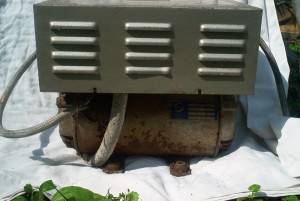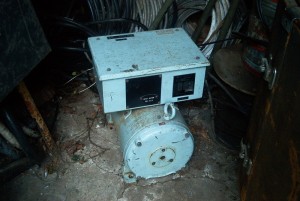On ships built before the 1950's (and some after), the electrical power was direct current (DC), often 220 Volts, but some ships had 110 Volts DC. This power was suitable for running compressor and winch motors and lights. However few, if any, electronic equipments could use the ships voltage directly. Hence the need for motor-generators (sometimes called rotary converters). Often a motor-generator was included in a "package" of electronic equipment, such as radar, gyrocompass or loran.
In the 1950's ships were built with alternating current (AC) electrical systems. Most often this power was generated at 440 Volts, 60 cycles per second, three phase. This power is suitable for running large motors, as for winches and compressors; for lights and many electronic equipment the voltage is stepped down by a transformer to 115 or 230 Volts, single phase. Ships built in Europe and South America tended to generate 380 Volts, 50 cycles per second, three phase.
Many electronic equipments can operate with alternating current, 115 or 230 volts 50 or 60 cycles per second. However, some equipment, particularly radars and gyrocompasses, required 1000 or 800 cycles per second. Motor-generators fulfilled this requirement, being driven from the three phase alternating current or from direct current.
Beginning in the late 1960's, certainly in the 1970's, electronic equipment used solid state converters, which could accept ships DC or AC power and provide voltage(s) required by the equipment, whether DC or AC.
Transmotor Copenhagen Denmark – ACMA-25
Manufactured by: Transmotor Copenhagen Denmark
Model: ACMA-25
Input Power: 440 VAC 3 phase 60 Hz, 0.8 A
Output Power: 115 VAC 1 KHz 1 Phase 250VA
Denki SYOKOSYA Co – MG-618-1
Manufactured by: Denki SYOKOSYA Co, Ltd, Tokyo Japan
Model: MG-618-1
Date of Manufacture: April 1974
Input Power: 220 VAC 3 Phase 50-60 Hz, 3.15 A
Output Power: 100 VAC 6A 1 Phase 800/1000Hz
100 VAC 1.5 A 1 Phase 50/60Hz


